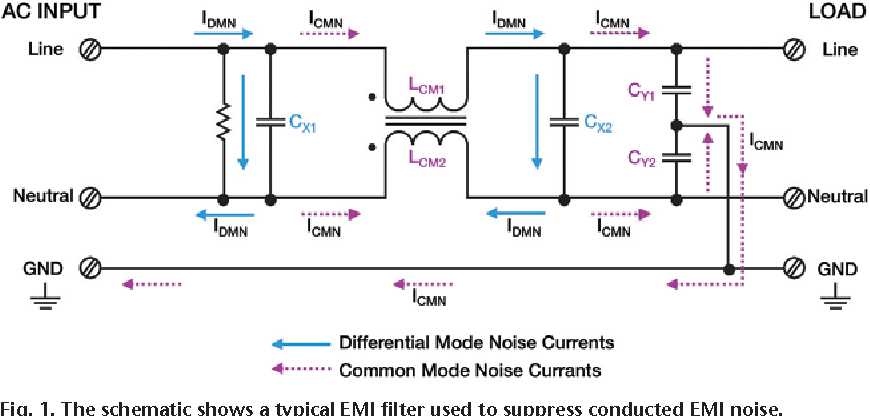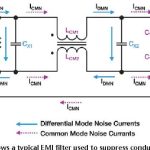In EMC testing, we often focus on common mode filtering—especially on power cables. It’s a good start, but let’s be honest: even solid filtering doesn’t always get you past CE compliance. That’s when labs suggest adding low-frequency ferrites, like Fair-Rite’s Material 31. Sometimes it works. But not always.
Here’s the real issue: a design mistake I’ve seen over and over again—especially in systems failing below 30 MHz. And no, ferrites won’t fix it.
The lack of bulk capacitors
In order to begin our analysis, let’s consider a DCDC converter’s typical CM filter topology:

Each DCDC converter power supply should follow the above topology. As an example, we have a common mode choke whose insertion loss is -30 dB, some ceramic capacitors designed to minimize differential mode issues above 1 MHz, and a bulk capacitor designed to stabilize voltage below 200 KHz.
Now imagine that even with a common mode filter with an insertion loss of -30 dB, we still fail CE.
What could be the problem? (I’m talking about emission below 30 MHz).
For us to understand what the problem might be, we must understand how power moves from the power supply to the Cbx and Ccx capacitors and from the capacitors to the DC/DC converter.
So let’s start considering the current loop from the Cbx and Ccx capacitors and the DC DC converter.

A DCDC converter is very demanding when it comes to “asking” current at high frequencies. Only ceramic capacitors fitted near the DC DC converter can provide this current.
Here is the blue current path.
Since ceramic capacitors are giving current to the DCDC converter, they require more charge, otherwise their voltage will decrease.
Ideally, the bulk capacitor (typically aluminium or tantalum) would provide this current. This current is shown in red.
Whenever the Cbx capacitor is large enough to supply that amount of current continuously to the Ccx capacitors, the above situation occurs.
Now let’s analyze what happens when Cbx is too small.

If Cbx is too small, then there will be a drop in voltage across Cbx, and the power supply will be the next current source. You can see the yellow arrow.
Unfortunately, the high frequency current from the power supply crosses the LISN, which means that we will start seeing high frequency emissions from the spectrum analyzer connected to the LISN. Due to the fact that this emission is caused by differential mode currents, a common mode chocke can be inefficient in this regard.
Increasing Cbx is enough to fix this problem.
⚠️ Why Ferrites Might Not Be the Answer
Let’s say your system pulls 4A. Adding ferrites sounds easy, but it affects:
- 💰 Cost
- 📏 Size
- 🔥 Heat dissipation (yes, ferrites get hot!)
So before you reach for a ferrite core, ask yourself: are you masking the real problem?
🔍 The Hidden Culprit: Undersized Bulk Capacitors
Let’s break down a typical DC-DC converter input filter:
- A common mode choke with ~–30 dB insertion loss
- Ceramic capacitors to handle differential mode noise above 1 MHz
- A bulk capacitor to stabilize voltage below 200 kHz
Now imagine you still fail CE—even with that –30 dB choke. What’s going wrong?
Here’s the loop: ceramic capacitors near the converter supply high-frequency current. But they need to recharge. That’s the bulk capacitor’s job. If it’s too small, the power supply steps in—and that current flows through the LISN, triggering emissions on your spectrum analyzer.
And since it’s differential mode noise, your common mode choke won’t help.
✅ Quick Fix: Check Your Bulk Cap Value
Before EMC testing, do this:
- Use a 3–5 meter cable between your power supply and device.
- Measure ripple at the input with an oscilloscope.
- If ripple >50 mV, increase your bulk (Cbx) or ceramic (Ccx) capacitor.
In most cases, ripple above 100 mV is a red flag during testing.
Bottom line: don’t underestimate your bulk capacitor. It’s often the silent hero—or the hidden villain—of CE compliance. Want help reviewing your layout or filtering strategy? I’m here for it.






Leave a Reply